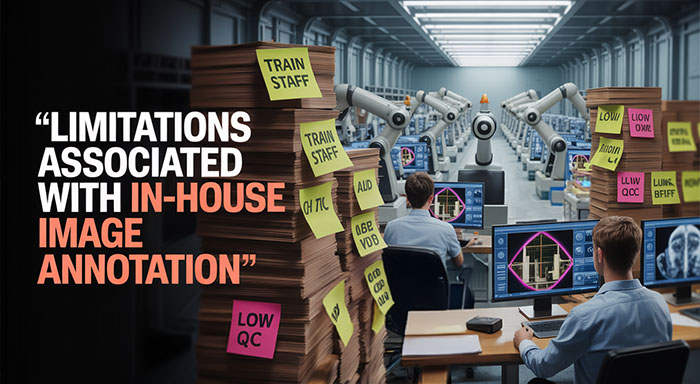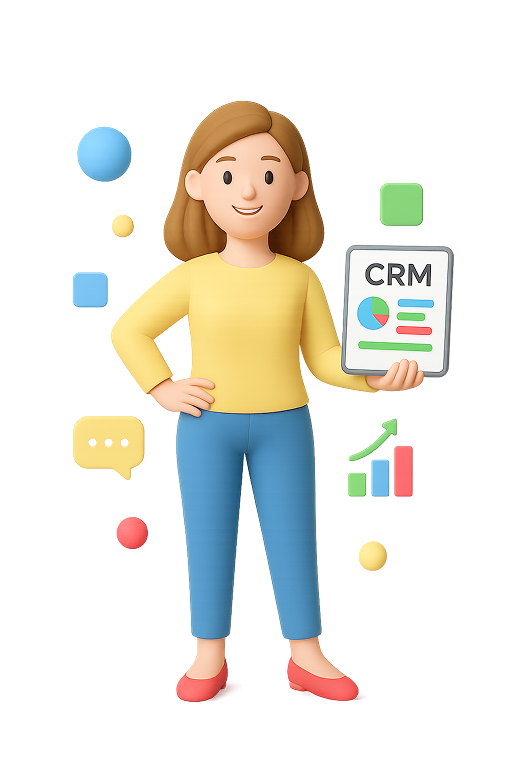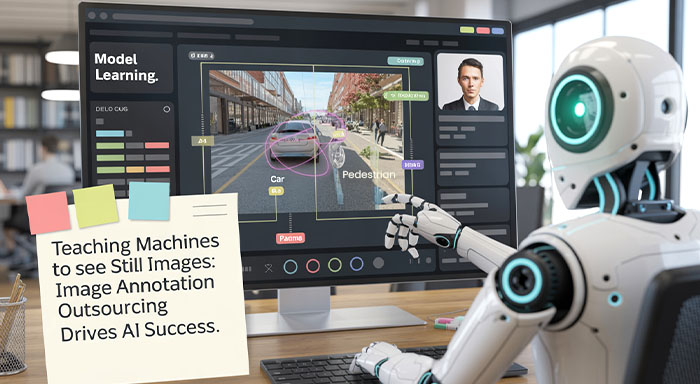In today’s AI-driven world, machines are getting better at seeing, identifying, and responding to visual data. But here’s the truth: computers don't "see" images the way humans do. An image that humans see as a dog, or a traffic light is perceived as merely a mass of pixels by an algorithm until it gets taught otherwise by someone.
“Someone” refers to the image annotation team behind the scenes. Self-driving cars, facial recognition systems or retail analytics – in order to understand the world, annotated images are greatly relied upon by AI models. Although the process sounds simple, it takes time, skill, precision, and scalability.
Therefore, companies seeking to establish reliable computer vision systems are adopting image annotation outsourcing as a strategic move while eliminating manual labeling tasks.
What Is Image Annotation?
Image annotation is the process in which labels or metadata are added to the images. This ensures that the machine learning models can identify objects, boundaries, features, and even emotions within those images. Such labeled datasets enable computer vision algorithms to learn the detection and interpretation of visuals as per the real world.
Annotations adapt to different forms depending on the purpose:
- Bounding boxes: Rectangles are drawn around objects such as cars, products, or faces.
- Polygon annotation: Precision-based outline drawing for irregularly shaped objects (e.g., animals, tools, medical structures).
- Semantic segmentation: Categorization and labelling of each pixel in the image. (e.g., road, pedestrian, sky).
- Key point annotation: Essential points pertaining to the objects or people (e.g., joints for pose estimation).
- Image classification: A label is assigned to the entire image for easy classification (e.g., “defective product” or “healthy plant”).
Modern AI applications in industries like healthcare, automotive, agriculture, eCommerce, and security are built on these annotations.
Importance of High-Quality Image Annotation
The quality of the data that you feed into your model has an immense impact on its accuracy. Poorly annotated images can weaken the model’s performance, resulting in expensive errors and unpredictable results.
For instance, if a medical diagnosis system is trained on images with sloppy labeling, such as misclassified tumors or missing abnormalities, the consequences could be devastating. Similarly, a drone navigation system with poor recognition capabilities for trees or buildings. The implications are real and often critical.
Benefits of efficient image annotation:
- Increased accuracy for the detection and recognition of objects.
- Fast-paced training cycle of machine learning models
- Reduced model retraining requirements
- Efficient and secure AI-powered applications
However, you need more than a labeling tool and a few clicks to achieve this level of quality.
Limitations Associated with In-House Image Annotation

The workload associated with producing high-quality label datasets is often underestimated by the AI teams. While the focus of the core AI developers would be on model architecture, data pipelines, and performance tuning, a large number of annotated images would have to be supplied by someone.
Some challenges of in-house image annotation are:
- Quantity: Large volume of labeled images is required for a single computer vision.
- Labor-intensive: The annotation process takes time and effort, particularly for complex images (ex: crowded urban scenes or microscopic medical scans).
- Training requirements: Basic training is required even for simple annotation tasks, especially when domain-specific expertise is involved.
- Quality control: It is difficult to maintain consistency in labeling across large teams and datasets.
- Opportunity cost: The resources spent on labelling can be directed towards R&D, business strategy, or product development.
Thus, outsourcing is not just a convenience but an essential.
Factors that Drive Companies to Outsource Image Annotation
AI projects rely on precision, scalability, and timely annotation. Outsourcing offers a solution that keeps you on track without burning through the internal resources.
Many organizations prefer image annotation outsourcing due to the following factors:
1. Annotation Team with Skilled Professionals
Outsourcing partners have established teams with professional annotators who have the skills, use advanced tools, understand project specifications, and deliver consistent results.
2. Scalability on Demand
Irrespective of the size of your label needs, an outsourcing partner can accommodate the scaling quickly without compromising on quality.
3. Built-in QA and Workflow Management
Reliable providers offer organized processes for quality assurance which includes double-blind reviews, spot checks, and annotation audits to ensure labeling accuracy.
4. Speed Without Quality Compromise
With large teams and optimized workflows, the turnaround time is reduced in outsourced providers.
5. Cost Optimization
Outsourcing enables flexibility for the companies. They can adopt a variable, project-based cost structure instead of fixed overhead (hiring, managing, training).
Industrial Benefits of Image Annotation
Nowadays, computer vision surrounds us, increasing the need for annotated visual data. Some sectors rely heavily on image annotation. They are:
- Driving Automations: Cars need to be trained to identify other vehicles, signs, pedestrians, and dynamic road conditions.
- Medical Imaging: AI-powered detection of tumors, anomalies, or organ structures from radiological scans.
- Retail & eCommerce: Product tagging, virtual try-ons, shelf tracking, and customer behavior analysis can be performed.
- Agriculture: Using drone footage or field images to determine crop diseases, plant growth stages, and livestock.
- Security & Surveillance: Improved facial recognition, behavioral detection, and anomaly spotting.
These use cases require specific annotation styles for varying domains, highlighting the importance of expert-level labeling.
Choosing the Right Outsourcing Partner
All annotation providers do not offer the same features and capabilities. These metrics can assist in examining a potential partner:
- Domain relevant experience in the industry.
- Availability of annotation tools to support your specific needs.
- Well-maintained documentation, guidelines, and communication channels.
- Established frameworks for QA and performance metrics.
- Data security protocols and regulatory compliance (e.g., GDPR, HIPAA).
The right partner will become a collaborative extension of your AI development team.
Final Thoughts: Don’t Let Data Labeling Hold You Back
Without good data, AI models cannot perform successfully. And great datasets begin with efficient annotations.
Outsourcing image annotation saves time and effort so that your internal teams can focus on building and deploying models. This speeds up development and provides a reliable base for your computer vision projects.
You could be launching your first AI tools or scaling an enterprise solution; outsourcing the annotation tasks ensures consistent quality, faster delivery, and lower operational risk. This way, your product can fulfill its purpose of seeing the world clearly and acting on it intelligently.
If you wish to enhance your vision AI pipeline with high-quality labeled data, consider outsourcing professional image annotation.




%201.png)

%201.png)

%201.png)

